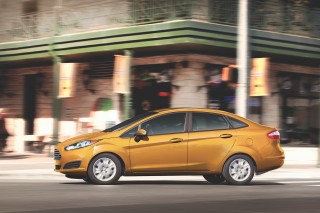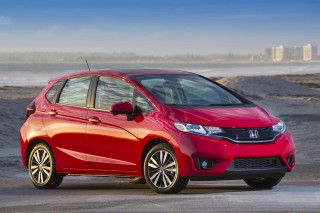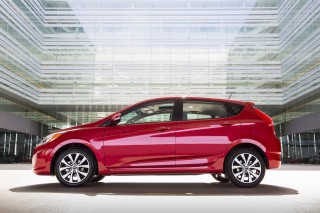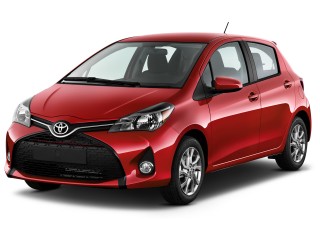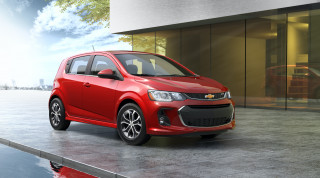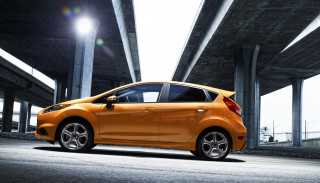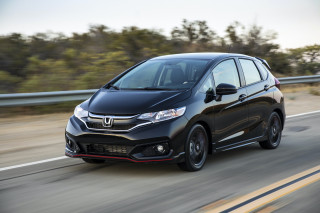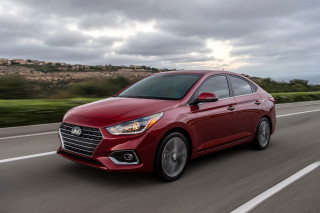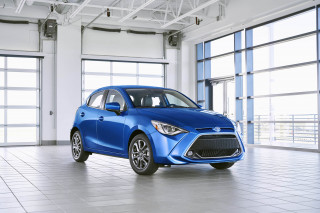Likes
- Front seat comfort
- Sporty, smooth, efficient turbo four
- Quiet cabin
Dislikes
- Harsh, gutless base engine
- Back-seat space tight for the class
Buying tip
features & specs
The 2017 Chevrolet Sonic gets some safety and feature improvements, and should continue to score big on refinement and driving fun.
The Chevrolet Sonic was a fresh nameplate four years ago—and in the U.S. the new path made a lot of sense, as it was refined, sporty, and far more safety-minded about-face from the Aveo that it replaced.
Now, with the 2017 Chevrolet Sonic, the automaker is revisiting and refreshing the compact car, with some changes to this small car’s front and rear styling, a better safety set, and some new features throughout. In light of that, the 2017 Chevrolet Sonic for the U.S. is now a lot closer to the front-end look of the international version, which is still called the Aveo in many other markets. It continues to be available as either a five-door hatchback or four-door sedan.
It scores a 6.5 out of 10 on our overall scale, thanks to very good fuel economy and great safety scores—important in the compact class. (Read more about how we rate cars.)
Styling and performance
Chevy points to the Sonic’s changes as being right in line with those given to other global Chevrolet compact vehicles, including the Cruze, Bolt EV, and refreshed 2017 Trax. That includes what the automaker describes as a more expressive look, with a redesigned hood, a new rear fascia, projector-beam headlamps, and LED daytime running lamps. Orange Burst Metallic, Brimstone, Cajun Red Tintcoat, and Arctic Blue Metallic are four new colors introduced for 2017, and wheel designs have been refreshed (still 15-, 16-, and 17-inch).
Powertrains for the 2017 Chevrolet Sonic essentially carry over from last year. Base Sonic models will be powered by a 1.8-liter inline-4, while an optional 1.4-liter turbocharged inline-4 gives better acceleration and higher EPA fuel economy ratings. We’ve found Sonic models with this 1.4-liter engine to be smoother, quicker-responding, and simply more fun to drive. The front-wheel-drive small car can be had with either a 6-speed manual or a 6-speed automatic.
On the road, the Sonic feels strong and sturdy, and its ride isn’t as coarse and busy as most other entries in this class. It’s enjoyable to drive, with electric power steering that offers particularly nice feel and weighting (often a weak point on Asian competitors). Overall, it has the settled, refined feel of a car an entire class larger; GM has lately excelled in making its cars quiet, and the Sonic is solidly better than average.
Comfort, safety, and features
It’s in packaging where the Sonic hasn’t quite measured up to some of its rivals. Front seats are quite good, and adjustable to a wide range of drivers, but back-seat accommodations are quite tight and by no means transcend this model’s subcompact status. It doesn’t offer the so-called Magic Seat arrangement of the Honda Fit, or quite as low of a load floor of other entries, but whether you choose the hatchback or sedan, its rear seatbacks do flip forward all the way to expand space.
Safety features in the 2017 Sonic are quite robust, with 10 standard airbags. A rearview camera system is now standard across the model line, while parking assist is newly available, as are forward collision alert and lane departure warning, two active-safety features that may help you keep away from trouble. The Sonic’s body structure is likely to carry over with no major changes, and that’s a good thing; up until now this model has earned excellent five stars in federal crash tests, as well as top "Good" ratings from the IIHS, including in that agency’s tough (and critical) small overlap frontal test.
Trim levels will be revamped. LS, LT, and Premier trims will be offered for the 2017 Sonic (LT and Premier only for the hatchback), replacing the LS, LT, LTZ, and RS trims of the 2016 model. The RS model is effectively replaced by an appearance package that’s offered on LT and Premier trims.
According to GM, the Sonic is the first model in its class to offer a power driver’s seat. Other new features offered in the lineup include a heated steering wheel, heated cloth seats, and a seven-inch infotainment system that includes Apple CarPlay and Android Auto compatibility. The system also has 4G LTE connectivity and a wi-fi hotspot.
2017 Chevrolet Sonic Styling
The Sonic gets a restyled front end and resculpted rear for 2017, and while the handsome profile of the hatchback carries, the homely sedan is ready for more of a makeover.
The Chevrolet Sonic was an about-face in most respects for GM, which had a long history of halfhearted attempts in the subcompact-car segment. But with the introduction of the Sonic give years ago, much changed—and styling was a big part of the new attitude.
We like the interior and exterior, which is reflected in our score of 7 out of 10. (Read more about how we rate cars.)
Overall, the Sonic has managed a very pleasant design balance. It's neither overly bold nor bland, and it managed to look modern without the bland, boxy econocar look of some class rivals that offer as much practicality as this. It's just handsome and conservative enough to still look good after a few years on the market—and some subtle but meaningful changes to this model's design this year give it just the right kind of refresh so it fits right in alongside other recently redesigned Chevy models like the Malibu, the upcoming Bolt EV, and even the Camaro.
What it means, exactly, is what we see as a more refined, expressive look, with a redesigned hood that flows more neatly from the grille and headlamps; meanwhile the headlights now meet up with the grille in more of a continuous horizontal strip. Airdams have been redesigned in front and in back, as has the entire rear bodywork (for a more chiseled look, as we see it).
Up close with the details, there are projector-beam headlamps, as well as LED daytime running lamps. Orange Burst Metallic, Brimstone, Cajun Red Tintcoat, and Arctic Blue Metallic are four new colors introduced for 2017, and wheel designs have been refreshed (still 15-, 16-, and 17-inch).
For the U.S., that takes it a lot closer to the front-end look of the international version, which is still called the Aveo in many other markets. It continues to be available as either a five-door hatchback or four-door sedan.
Inside, the Sonic shows its age a little bit more, as it's a version of the twin-cockpit look that dominated larger Chevrolet sedans of a few years ago. The center of the dash curves down through a V-shaped center stack into a console area that wraps around the front-seat riders. But at the center of the dash, new 7.0-inch infotainment systems in some versions will change the look somewhat for 2017.
Behind the steering wheel, a "motorcycle-inspired" instrument cluster stands proud of the dashboard itself. The only major gauge is actually the tachometer, with a numeric speed readout and a host of digital icons and graphs and lights. (The monochrome display is one area where the Sonic shows its age.).
The materials are upscale for a subcompact, and the three-spoke steering wheel reinforces the Chevrolet identify. Touches you might not expect in a subcompact include chrome trim rings around circular elements, used sparingly, and contrasting materials with different grains for the upper and lower parts of the dash. Even after several years, it's well done, and feels like it costs more than it does. Chevy also gets credit on the outside, for fitting alloy wheels to every single Sonic—even the base LS model. No grim plastic covers over steel wheels here.
Ultimately, the biggest design choice you're going to make within the Sonic lineup is between the hatchback and sedan. We find the hatchback a far more cohesive design, with its angled window line ending in a truncated tail. Handles of the rear doors are "hidden" in the rear doors, ticked with the black trim connecting the roof pillar and door, for a slightly coupe-like look. And overall, the hatchback's short rear and longer front overhangs give it proportions that impress are sportier.
The Sonic four-door sedan has the same wheelbase, but it gets conventional rear doors, a longer roof, and a surprisingly large trunk. In all, it's less of a consistent design as a whole, and can look from some angles like three different ideas stamped together. Perhaps not too surprising, Chevy sells more Sonic hatchbacks—and fewer sedans, relatively—than it predicted.
2017 Chevrolet Sonic Performance
The peppier, smoother, and more fuel-efficient 1.4-liter turbocharged inline-4 remains the way to get the 2017 Chevy Sonic.
Chevrolet locked in the Chevy Sonic's engine and transmission lineup with its launch many years ago. That hasn't changed over time, and we consider it to be a good thing—as in past years, provided you step up to the 1.4-liter turbocharged inline-4, which is a low-cost option on most of the lineup.
We gave the Sonic one point above average for its sorted suspension and fun-to-drive character. (Read more about how we rate cars.)
While that engine gives the Sonic just the right smooth, strong, refined character to blast all memories of the Aveo and miserly, miserable econoboxes out of your memory, the base 1.8-liter non-turbo engine could bring it all back into focus, as its raspy character, narrow power band, and unimpressive real-world mileage are all reasons to avoid it.
Both are rated at 138 horsepower, and with each you can get either a 6-speed automatic or a manual (5-speed for the base 1.8 or 6-speed with the turbo).
Good steering feel and a well-tuned suspension make the Sonic a joy to drive. In previous model years, an RS model has offered an even sportier feel from a lowered and tuned suspension and lower gear ratios. For 2017, Chevrolet is only offering the hatchback in RS guise, and making the package available on the the sedan as an option.
Outside of a rather mushy brake pedal (stopping power has been just fine) on nearly all the Sonics we've driven, our sole quibble with the turbo versions is that throttle response can sometimes lag the pedal input for a fraction of a second. On the other hand, the 6-speed manual is downright fun to drive with the smaller engine because it offers precise, direct shift action with pleasingly short throws. The clutch is smooth and almost impossible to get wrong.
The automatics here aren't bad either; with the turbo you get up- and down-shift buttons on the side of the lever for added sportiness. Leaving it in Drive is just fine, though—though with the 1.8-liter it will be hunting around more to keep moving briskly.
2017 Chevrolet Sonic Comfort & Quality
The 2017 Chevy Sonic continues to outdo many rivals with its quiet ride, decent handling, and room for four adults.
The 2017 Chevrolet Sonic carries over with excellent ride comfort and one of the quietest cabins in its class. But it comes up short in passenger space and cargo versatility compared to some other models that are essentially the same size on the outside.
We like the hatch's versatility and cargo space, and have awarded a point above average based on that. (Read more about how we rate cars.)
There's room for four passengers in the Sonic, with enough leg room to accommodate adults front and rear, if you manage some negotiation. Front seats in the Sonic are quite good, and adjustable to a wide range of drivers, but back-seat accommodations are quite tight (in head room especially) and by no means transcend this model’s subcompact status.
In front, the Sonic serves up plenty of trays, bins, and cubbies up front to hold glasses, toll tickets, change, phones, sodas, and all the rest of the stuff you carry in your car these days.
What you won't find in the Sonic is any trick seat-folding, or an extraordinarily low or flat cargo floor—although whether you choose the hatchback or sedan, its rear seatbacks flip forward all the way to expand space.
It mostly makes up for that in sheer volume. The hatchback has a remarkably large 19-cubic-foot cargo area, making it possible to accommodate long packages and still close the hatch. It also has a hidden storage area underneath the high load floor that's large enough to hold a laptop bag. And the sedan boasts a 14.9-cubic-foot trunk, which is the same size as that of the Nissan Versa Sedan—although here the opening is larger.
The Sonic had one of the quietest, best-insulated cabins in the class when it was introduced more than five years ago, and while the competition has started to catch up it still remains one of the better picks in this class for general ride comfort. Road and engine noise are muted—although we'd stick with the mid-level LT model for the quietest ride and avoid the 17-inch wheel-and-tire upgrade of LTZ models (and the RS) as it's a bit noisier and rough-riding.
2017 Chevrolet Sonic Safety
Great safety ratings are expected to carry over, while the feature set gets even better.
Although the Sonic gets a few more available active-safety features for 2017, its body structure carries over with no major changes, and that's a good thing.
Federal testers gave the Sonic a five-star overall rating and the IIHS gave it top "Good" scores in every category, but stopped short of calling the Sonic a Top Safety Pick. That earns a 7 out of 10 on our books for safety. (Read more about how we rate cars.)
The 2017 Chevrolet Sonic comes standard with 10 airbags. Blind-spot mirrors come standard at all trim levels, as is a rearview camera system. Rear parking sensors are newly available this year, in addition to forward-collision warnings. There's no automatic emergency braking, but that's still a rare feature among subcompacts.
2017 Chevrolet Sonic Features
Better infotainment systems and new trim levels are the news for the 2017 Sonic lineup—but the value's still in the mid-range LT.
With the Chevy Spark just below the Sonic as the most affordable Chevrolet model, and the Cruze sedan just above it as a more spacious entry, the Sonic fits into a niche that's sportier and more refined than either of those entries.
Equipment for the Spark is good for a compact, but not luxurious considering its price. Our rating of 5 is average for most new cars. (Read more about how we rate cars.)
To that, there's no stripped-down Sonic. Even the base LS model, with its 1.8-liter engine, comes standard with air conditioning, steering-wheel audio controls, keyless entry, and Bluetooth connectivity.
Trim levels have been revamped for the whole 2017 Chevrolet Sonic lineup. LS, LT, and Premier trims will be offered for the Sonic (LT and Premier only for the hatchback), replacing the LS, LT, LTZ, and RS trims of the 2016 model.
The RS model is effectively replaced by an appearance package that’s offered on LT and Premier trims; it appears that the performance enhancements that used to go along with the RS as a standalone model (like the lowered suspension, lower gear ratios, and performance exhaust) have been discontinued.
The top-of-the-line Sonic Premier will likely parallel the former LTZ, adding larger 17-inch alloy wheels, cruise control and fog lamps as standard, along with heated front seats upholstered in leatherette.
According to GM, the Sonic is the first model in its class to offer a power driver’s seat. Other new features offered in the lineup include a heated steering wheel, heated cloth seats, and a 7.0-inch infotainment system that includes Apple CarPlay and Android Auto compatibility. The system also has 4G LTE connectivity and a wi-fi hotspot.
2017 Chevrolet Sonic Fuel Economy
The 1.8-liter base engine earns respectable ratings, but the better real-world numbers may be had with the 1.4-liter turbo engine.
The 2017 Chevrolet Sonic comes with two different 4-cylinder engines and a choice of two different transmissions for each; yet there are a surprising number of variants, each with slightly different fuel economy ratings.
Based on its size and engine, the Sonic scores very well for a non-hybrid on our fuel-efficiency scale. (Read more about how we rate cars.)
The EPA deems the most fuel-efficient Sonic to be the 1.4-liter turbo with the 6-speed manual gearbox, rated at 28 mpg city, 38 highway, 32 combined. Go for the 6-speed automatic, as most buyers will, and you'll still see 27/36/30 mpg.
If you opt for the base 1.8-liter inline-4, it's rated more fuel-efficient with the 5-speed manual at 25/33/28 mpg; the 6-speed automatic brings it down slightly, to 24/34/28 mpg.
We strongly recommend the modestly higher-priced 1.4-liter turbocharged models, which are more fuel-efficient, peppier, smoother, and more fun to drive. The turbo doesn't require premium fuel either. The base 1.8-liter engine costs less, it drinks more fuel. It's also less fun to drive, so we think the payback is pretty clear.






































































































